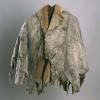Quilt No.590PR - Patricia Roche

The rug was made at the Schultz tannery in Wagga Wagga from local Riverina fox skins in the early 1950s. It is thought that Mr. Lancaster, who was married to a Schultz, did the actual making. When Patrick Roche went to collect an opossum skin rug being made for him he saw the fox tail rug and purchased it. It was owned by Patrick and now by his daughter Patricia. It is not used now.
*The Schultz Wagga Wagga Tannery [notes from Harry Schultz Feb.2000]
The German side of the family came out about the 1930s, when many other Lutherans came to South Australia. They were furriers, tanners and dyers in Germany.
"My dad said he was apprenticed to his uncle in Bordertown. He ran away and crossed the 90 mile desert with some lemons and 3 dogs." He was William Adolf Schultz, born about 1880, died about 1960. Mother, Anne Sophia Hood, was born in Bordertown her father struck gold at Ballarat, 'not lucky but consistent'.
The family went to Albury but by about 1911 were also farming and investing in Wagga, but all that collapsed in 1929. Harry's father started the tannery in Albury but then shifted to Wagga for good about 1930. Before the depression fur coats were the 'in' thing. The Wagga tannery started as a backyard business near the Waterworks. Father made the coats and Mother employed dressmakers to do the linings. At one stage they had a workroom above Kelly and Cunningham's in Fitzmaurice St. The skill of a furrier is as a cutter and being able to match skins. If you made a pattern you knew what you were working to.
There were 10 children. 4 brothers and a brother-in-law went to the war. Hartley lost his arm with a bomb.
WW2 was a turning point for the tannery as the Yanks were stationed here at Kapooka. They all had money and wanted something Australian so kangaroo and possum rugs were very popular. The tannery moved to Hammond Avenue (the caravan park is now part of it). The tannery site was fairly recently sold to Noah's Ark. Pre war the business was mainly coats and after the war mainly rugs. Hartley gradually took over from his father. Harry would often do the heavy work like fleshing.
Acid does the tanning and there are many types of acids: alum and salt, tea leaves, ash. Wattle bark was very popular for tannic acid. There was a big trade for stripping bark for export. We used to go out stripping bark. At certain times of the year moisture coming up from the roots starts new growth and that's when you cut the bottom part and strip up into long lengths and leave to dry out. We would go back in a month or so and get the dry bark. It would then be chopped into small pieces, boiled up and the fluid drained off into casks. This was the tannic acid. Black wattle was stronger in acid. There were many trade secrets handed down to do with tanning. After the war wattle bark (tannic acid) was imported from South Africa in large blocks (like cheese) so getting wattle bark in the bush ceased.
Father was about the only one who knew how to regenerate skins so he would get them cheap. Police would confiscate skins of protected animals but then the skins would turn up at the sales. Father might buy a couple of hundred skins at winter sales and then make them up in summer. Possum skins were very warm. Kangaroo fur didn't wear well but the hide is long wearing. The best wearing skin was from the native cat and Dad would pay 9d or 10d for these. Platypus are and were protected but trappers still used to trap them. They are silvery grey on the stomach and dark grey on the back. Skins would be slit up the back so the silvery grey would be in the centre.






